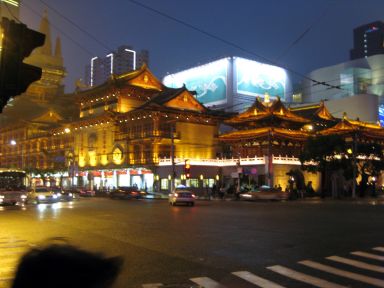
2010-05-22: Temple at Night
Today, Shanghai is again thriving and is among China's fastest growing cities. We walked the area around our hotel tonight and thought this temple was indeed a mixture of the old and new. I guess the city grew around it!
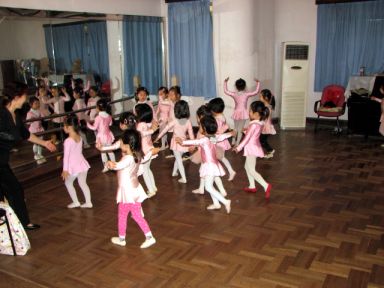
2010-05-23: Children's Palace
Following the Cultural Revolution, Children's Palaces were created all over China for after school care for children of working parents. Today they are designed for children to study and practice traditional Chinese art after school and on weekends. Children attend to study dance, the theater, learn to play a musical instrument, and paint. We were lucky to get to see this group of young ballerina's learning to dance.

2010-05-23: Mini-Concert
These two teens have been studying at the Children's Palace since they were youngsters and planned a mini-concert for us. She played the piano and flute while he was accomplished on the Chinese violin.
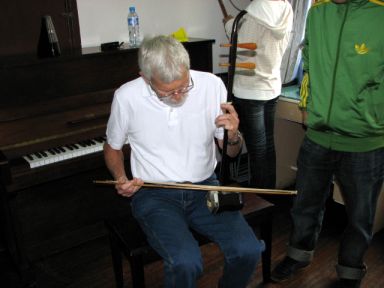
2010-05-23: Chinese Violin
Al gave the violin a try but could only get it to squeal while the young man could make it to sing!
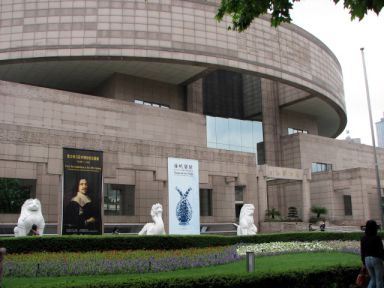
2010-05-23: Shanghai Museum
Our next stop was the Shanghai Museum that was established in 1952. It boasts a collection of 120,000 pieces of Chinese cultural relics in 21 categories including collections of bronze, ceramics, calligraphy, and paintings for which it is renown.
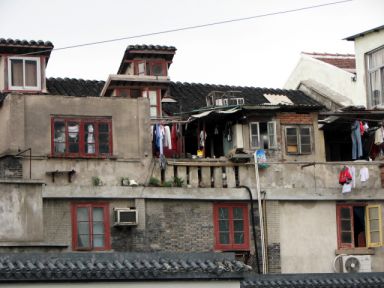
2010-05-23: Old Town
Driving around the city from one place to another you can still see sections where the old houses have not been replaced apartment buildings or skyscrapers.
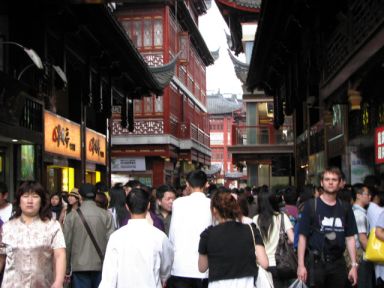
2010-05-24: Bazaar
Entering the bazaar area was like entering another world. We had been places where there were lots of people but nothing like this. You couldn't walk, you just got moved along. It was probably the only place during our 2-weeks in China that I didn't feel particularly safe.
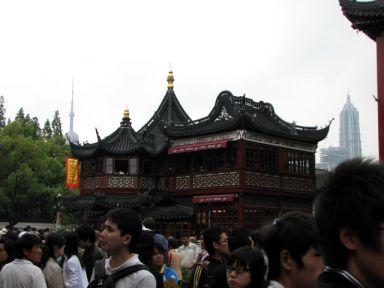
2010-05-24: Old and New
It was interesting to see this old teahouse with the modern skyscrapers in the background as we were moving (or being moved) along the zigzag bridge on our way to Yu Yuan Garden.
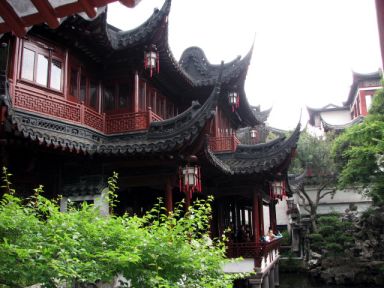
2010-05-24: Yuyuan Garden
Yuyuan Garden is a famous classical garden. The garden was finished in 1577 by a government officer of the Ming Dynasty (1368-1644) named Pan Yunduan. Yu in Chinese means pleasing and satisfying, and this garden was specially built for Pan's parents as a place for them to enjoy a tranquil and happy time in their old age.
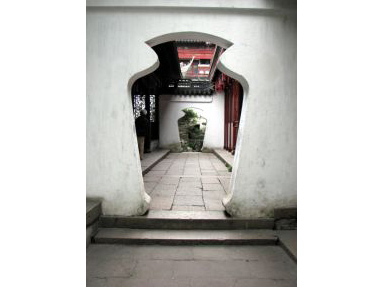
2010-05-24: Yuyuan
In the 400 years of its existence, Yuyuan Garden has undergone many changes. During the late Ming Dynasty, it became very dilapidated with the decline of Pan's family. In 1760, some rich merchants bought Yuyuan Garden and spent more than 20 years reconstructing the buildings. During the Opium War of the 19th century, Yuyuan Garden was severely damaged. The Yuyuan Garden you see today is the result of a five-year restoration project, which began in 1956.
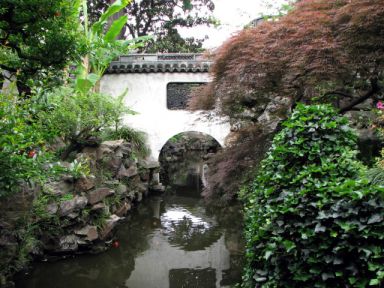
2010-05-24: Yuyuan
Yuyuan Garden occupies an area of 20,000 square meters (about five acres). The pavilions, halls, rockeries, ponds and cloisters all have unique characteristics. There are six main scenic areas in the garden: Sansui Hall, Wanhua Chamber, Dianchun Hall, Huijing Hall, Yuhua Hall and the Inner Garden. We were told this tree is not a Japanese maple but rather a Chinese chicken foot maple.
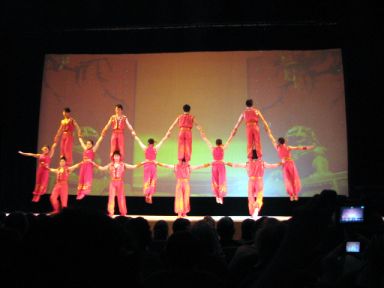
2010-05-24: Acrobatic Show
Dating back to 475-221BC, acrobatics in China enjoys a history of over 2000 years. It is one of the art forms most popular among the Chinese people. By 300 BC, such skills as walking on 3-meter high stilts and juggling 7 daggers at a time had been developed in China. In the Han Dynasty, acrobatic shows became important amusements frequently enjoyed at palace banquets as well as celebrations of the common people.
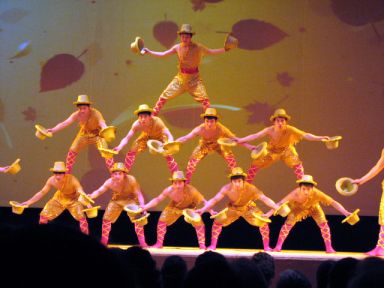
2010-05-24: Amazing
The acrobats in modern China have set up a designing and directing system aimed at creating graceful stage images, harmonious musical accompaniment, and good supporting effects of costumes, props, and lighting in order to bring about a fully developed stage art.
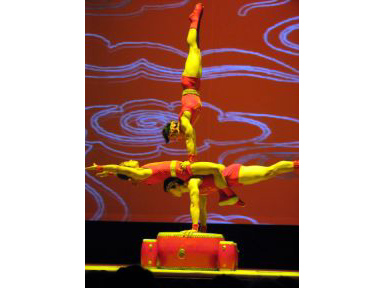
2010-05-24: Balance
Look carefully at what these three men are doing!

2010-05-24: Silk Factory
A visit to China would not be complete without a visit to a silk factory. When I was teaching, my class always raised silk worms but I never took the process to the end. Here I learned how they got the silk from the cocoons. After soaking the cocoon in hot water, the operator finds an end piece and is then able to unravel one very long strand of silk that is not even as big as one strand of hair.
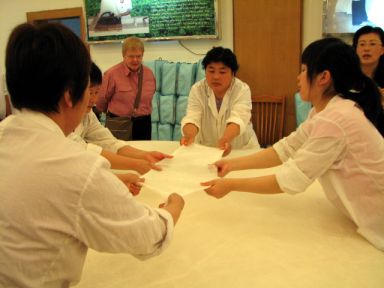
2010-05-24: Stretching
This was the process used to stretch and layer the silk when making a duvet insert.
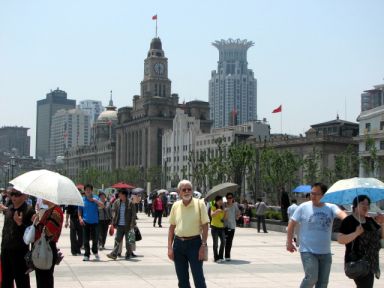
2010-05-24: Bund
The Bund is Shanghai's bustling riverfront boulevard that was once the center of European influence in the Far East. On one side of the Huangpu River are dozens of historical buildings that once housed numerous banks and trading houses from England, France, the US, Russia, Germany, Japan, the Netherlands and Belgium among others. A building boom at the end of 19th century and beginning of 20th century led to the Bund becoming a major financial hub of East Asia.
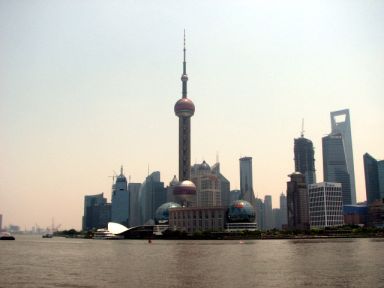
2010-05-24: New
Across the river one finds the modern skyscrapers of Shanghai. Our guide pointed out the building that looks like a bottle opener many times which leads me to believe they are particularly proud of that structure!

2010-05-24: Flower Pots
We were intrigued with these flower displays along the Bund and finally figured out how they did it. The flowers are in individual pots that are then placed on their sides and piled.